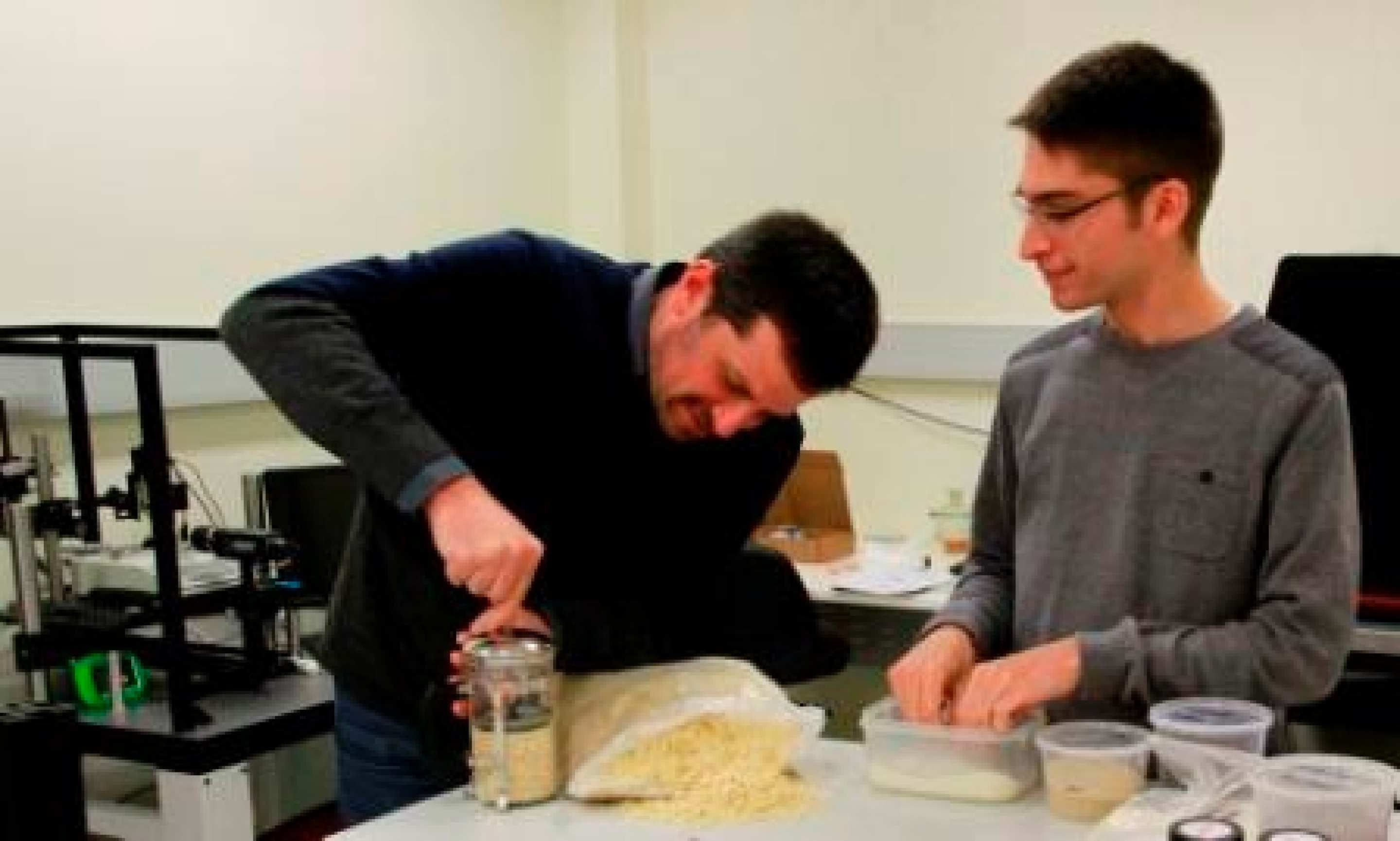Connect with us
Follow us on social media


Professor Itai Einav and Dr Francois Guillard conducting experiments with puffed rice cereal
Did you know that highly-porous, brittle and soft, puffed cereal grains share similar properties to varieties of rocks and dry snow?
It’s an observation not lost on Professor Itai Einav and Dr Francois Guillard from the Sydney Centre in Geomechanics and Mining Materials (SciGEM), who are using cereal to effectively model how similar materials behave when exposed to
various conditions.
To date, the self-monikered “cereal killers” have utilised the breakfast favourite to examine the movement and crushing of brittle, porous materials when compressed and their properties when introduced to fluids.
“Puffed rice is just one example of brittle porous media,” explains Professor Einav, Director of SciGEM.
“Aside from cereal, brittle porous media also include rocks and dry snow, as well as manufactured lightweight porous concretes and foams used as heat insulators and shock absorbers.
“The lower strength of puffed rice allows us to conduct scaled down experiments at an accelerated rate in our laboratories – something that would be logistically impossible to do with 100 metre-high actual rock!”
In 2015, Professor Einav and Dr Guillard led an international collaboration including researchers from San Diego State University to research the movement and crushing of porous materials when compressed using the puffed rice cereal.
Their findings, published in journal Nature Physics, shed new light on understanding such phenomena as snowballs colliding during avalanches and crater patterns formed during meteorite impacts.
“We knew that brittle, porous materials exhibit irreversible compaction patterns, but not in what ways they move and deform, or the types of internal patterns that develop,” explains Professor Einav.
“Puffed rice cereal was selected as we wanted to understand how packs of brittle grains coordinate motion when crushed. This simple experiment revealed surprisingly rich compaction patterns that were due to the competing processes of internal collapse and recovery.
“These different patterns of compaction can be useful to rationalise the behaviour of brittle, porous media such as sandstone, volcanic ashes and manufactured materials like metallic foams.”
The geomechanical engineers soon expanded on their previous work to determine the mechanical response of using puffed rice cereal, in particular how it reacts when the compaction velocity is changed.
What they discovered in this series of experiments proved surprising and documented in depth in a 2017 edition of Physical Review Letters.
“Most material would get stronger the faster you press on them but puffed rice is an exception – it actually gets softer,” notes Dr Guillard.
“This is a phenomenon called ‘strain-rate softening’ and demonstrated instabilities and compaction bands similar to those previously observed in metals.
“A good understanding of how instability develops in any material is crucial to trying to prevent their occurrence if possible.
“Although we studied only a particular class of material in the guise of brittle, porous media, we believe the conclusion we drew could be translated to a much wider range of materials.”
By understanding the role of strain-rate softening on the motion of puffed rice, the researchers hope to improve the understanding of instabilities in other materials that exhibit strain-rate softening, such as stick-slip phenomena that are know to control earthquake dynamics.

A) Experimental device and puffed rice.
(B) Stress-strain curves for various compaction velocities. Each curve is offset 50 kPa from the previous one for clarity. Left ordinate: Stress scaled by the typical constrained modulus of the puffed rice, 15 MPa.
Anyone who loves Kellogg's Rice Bubbles knows that cereal grains crush under load or become soggy in fluid over time. But what happens when they are both loaded and soaked at the same time?
This was the premise of the pair’s recent 2018 paper in Science Advances, which revealed the discovery of ‘ricequakes’: the sudden collapses of columns of wetted puffed rice that produce perpetual clicking sounds akin to a slowing metronome.
“We’ve happily studied dry puffed rice so adding milk seemed the most logical extension of our research,” says Professor Einav.
“We used milk, skim milk and water, and always got essentially the same result – the sounds of ‘ricequakes’.”
Scientifically, a ‘ricequake’ happens when the fluid reacts with the sufficient amount of time to weaken the supporting structure to a point where it will no longer hold the top stress without collapsing internally.
Collapses in sinkholes, ice shelves and rockfill dams involve brittle porous media, which can weaken under the action of wetting-induced degradation by chemically active fluid.
In showing that their model for puffed rice and milk can explain ‘ricequakes’, the researchers have opened the doors for better predictions of icequakes in Antarctica, or collapse of rockfill in high embankment dams.
“Fascinatingly, the dynamics of recurring ‘ricequakes’ we found in cereal are quite reminiscent to recurring tidal icequake dynamics in Antarctica!,” says Professor Einav.

A) Macrophotography of an area surrounding the interface between the soaked and unsaturated parts.
(B) Spatiotemporal plot of the material texture under the red line in (A), which shows recurring incremental compactions during ricequakes interluded by creep phases. The red dashed line in (B) highlights the position of the interface.
What’s next for these engineering “cereal killers”?
“There’s geophysics everywhere in our breakfast,” says Professor Einav.
“Our focus is on using puffed rice as a model of rocks and snows, but that’s not to ignore the idea of constructing a model for the folding of ductile rocks using stacks of waffles or pancakes, or heating porridge to model for mantle convection.”